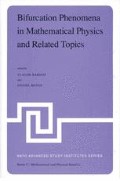Abstract
By a generally accepted philosphy, the basic constituents of hadrons (protons, neutrons, mesons, etc.) are quarks. But quarks have never been directly confirmed by experiment because they have never been isolated. The proposition has been that quarks are permanently confined inside hadrons and cannot be liberated in high energy particle collisions. It is expected that pairs (and some triplets) of quarks are attracted by forces which increase linearly with the distance between quarks. Thus when the quarks are near to each other they behave like free particles (“asymptotic freedom”), while when they are separated their attractive forces keep them together in the form of a bound state. According to this philosophy, we observe only these bound states (i.e. protons, neutrons, mesons, etc.)
Lectures given at Institut d’Études Scientifiques de Cargèse, on “Bifurcation Phenomena in Mathematical Physics and Related Topics” (June 24 – July 7, 1979).
Access this chapter
Tax calculation will be finalised at checkout
Purchases are for personal use only
Preview
Unable to display preview. Download preview PDF.
References
A.M. Polyakov, Phys. Lett. B59, 82 (1975).
A.A. Belavin et al., Phys. Lett. B59, 85 (1975).
V. de Alfaro, S. Fubini, and G. Furlan, Phys. Lett. B65, 1963 (1976).
R. Jackiew, C. Nohl, C. Rebbi, Phys. Rev. D15, 1642 (1977).
T. Glimm and A. Jaffe, Phys. Lett. B73, 167 (1978).
T. Jonsson, O. McBryan, F. Zirilli, and J. Hubbard, Commun. Math. Phys. (1979).
G. ’t Hooft, Phys. Rev. Lett. 37, 8 (1976).
C. Callan, R. Dashen, and D. Gross, Phys. Lett. B65, 354 (1976).
G. ’t Hooft, Phys. Rev. D14, 3432 (1976).
M.F. Atiyah, N.J. Hitchin, and I.M. Singer, “Self-duality in four-dimensional Riemannian Geometry,” Proc. Roy. Soc. London, Ser. A, 362 (1978) 425–461.
C. Callan, R. Dashen, and D. Gross, Phys. Rev. D.
J. Glimm and A. Jaffe, Phys. Rev. D18 (1978) 463.
C. Loewner and L. Nirenberg, “Partial Differential Equations Invariant under Conformal and Projective Transformations,” Contributions to Analysis, Academic Press (1974), pp. 245–272.
K. Uhlenbeck, “Removable Singularities in Yang-Mills Fields,” Bull. Am. Math. Soc. 1 (1979) 579–581, and preprint.
J.P. Bourgiugnon, H.B. Lawson, and J. Simons, “Stability and Gap Phenomena for Yang-Mills Fields,” Proc. Nat. Acad. Sci. USA. (to appear).
A. Schwarz, Phys. Lett. 3 167, 172–174 (1977).
R. Hartshorne, Commun. Math. Phys. 59 (1978) 1–15.
V. Drinfeld and Yu Manin, Funct. Anal, i Prilozhen. 12:2 (1978) 81; Uspehi Math. Nauk 33: 3 (1978) 241.
M. Atiyah, N. Hitchin, V. Drinfeld, and Yu Manin, Phys. Lett. 65A (1978) 185.
G. ’t Hooft, “On the Phase Transition Towards Permanent Quark Confinement,” Nucl. Phys. B138 (1978) 1, and “A Property of Electric and Magnetic Flux in non-Abelian Gauge Theories,” preprint (1979).
R.H. Fowler, Quart. J. Math. 2 (1931) 259–288.
J. Cervero, L. Jacobs, and C. Nohl, Phys. Lett. 69B (1977) 351.
M. Obata, J. Diff. Geom. 6 (1971) 247–258.
B. Gidas, W.M. Ni, and L. Nirenberg
C.B. Morrey, Multiple Integrals in the Calculus of Variations, Springer-Verlag, N.Y. (1966).
Author information
Authors and Affiliations
Editor information
Editors and Affiliations
Rights and permissions
Copyright information
© 1980 D. Reidel Publishing Company
About this paper
Cite this paper
Gidas, B. (1980). Euclidean Yang-Mills and Related Equations. In: Bardos, C., Bessis, D. (eds) Bifurcation Phenomena in Mathematical Physics and Related Topics. NATO Advanced Study Institutes Series, vol 54. Springer, Dordrecht. https://doi.org/10.1007/978-94-009-9004-3_15
Download citation
DOI: https://doi.org/10.1007/978-94-009-9004-3_15
Publisher Name: Springer, Dordrecht
Print ISBN: 978-94-009-9006-7
Online ISBN: 978-94-009-9004-3
eBook Packages: Springer Book Archive

